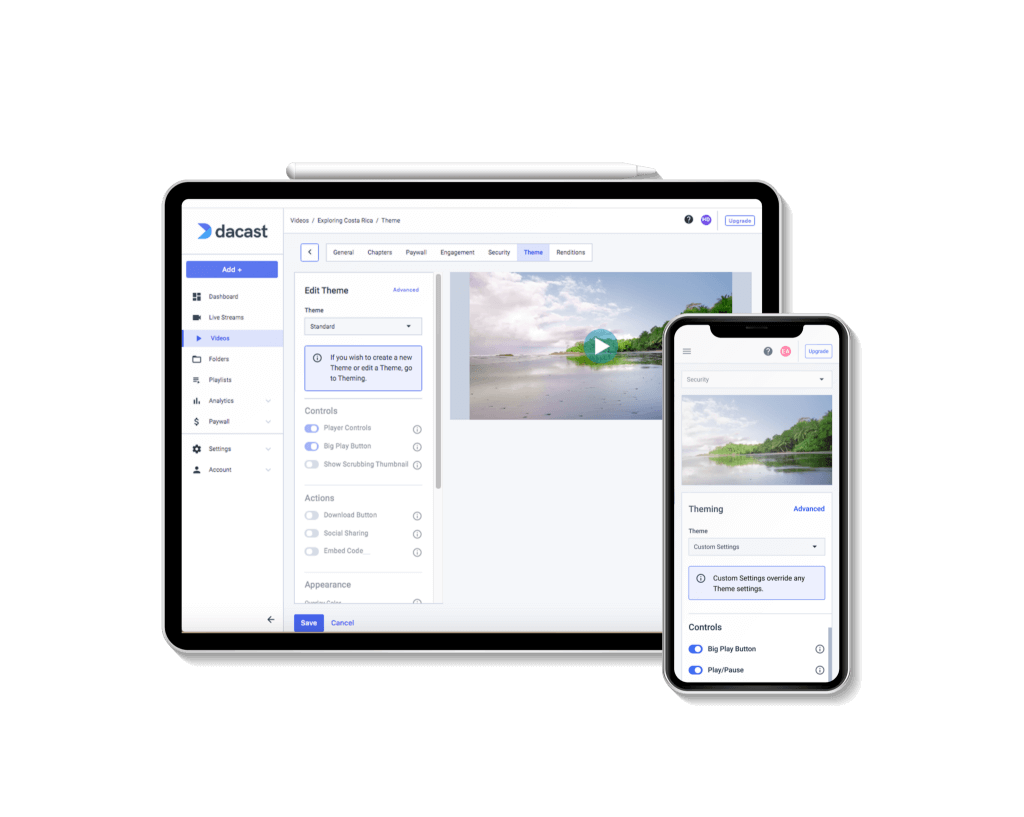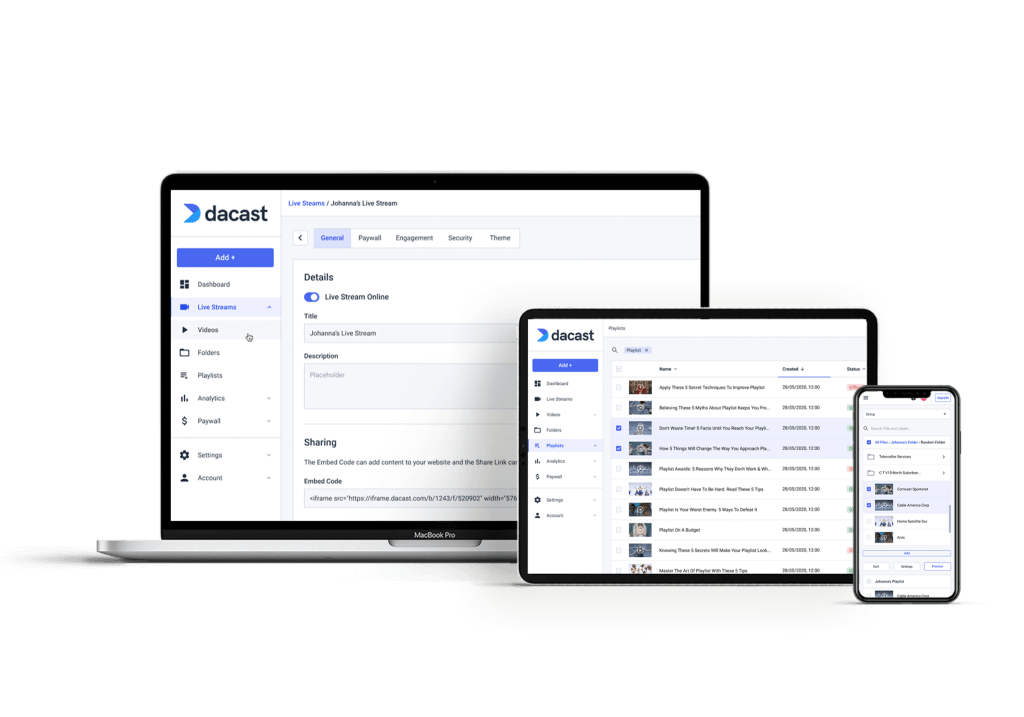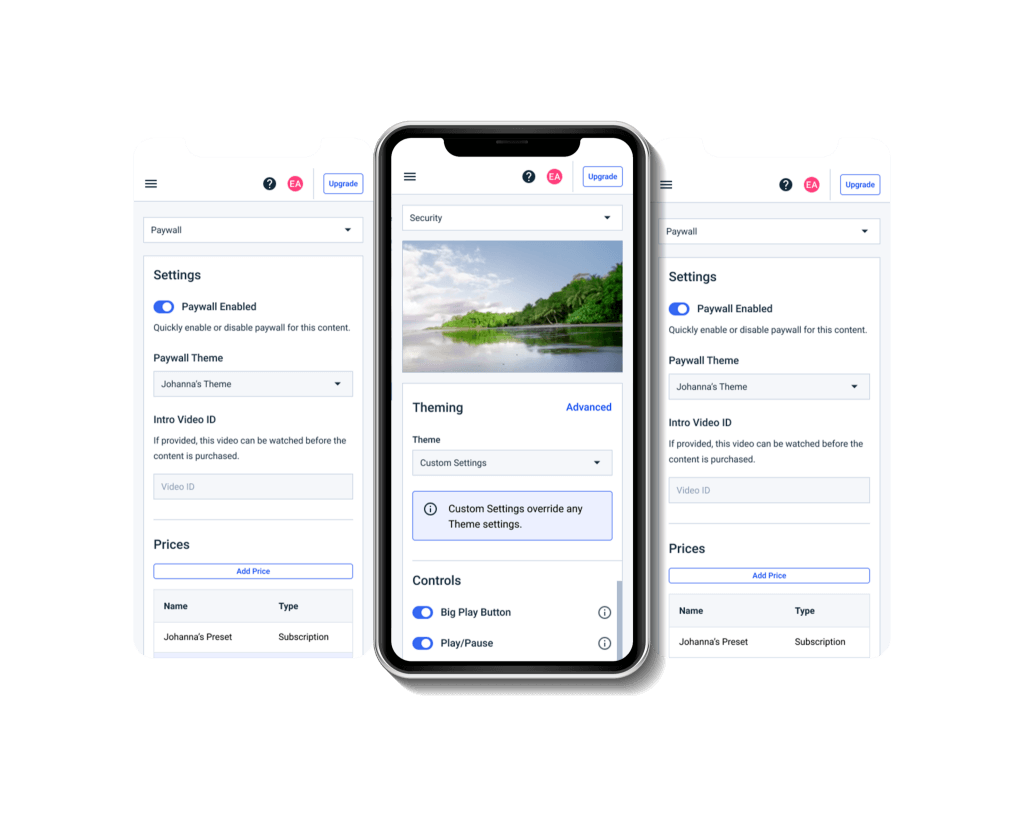How To Build a Live Streaming App on iOS and Android [2024 Update]
Modernity requires nearly all of us to have a mobile device on us at all times. For both work and play, people increasingly rely on mobile devices to tune in. One of the most prominent examples of how people use their mobile devices today is to live-stream video content.
An estimated 2.72 billion people will watch video on their mobile devices in 2023. Furthermore, data shows that live streaming accounts for 23% of global viewing time in 2024. Naturally, many savvy businesses and creatives are utilizing this upward trend by creating their own live-streaming mobile app.
In this article, we cover building your very own live-streaming app. We’ll help you enter the global live-streaming market by getting you off on the right foot. You’ll learn where and how to start, and get a better grasp of the industry’s background. Furthermore, we’ll compare the different types of live streaming apps for viewing mobile device content and broadcasting live video. Finally, we’ll distil the finder points revolving around the technical details, including setting up mobile apps via APIs and SDKs from professional video streaming platforms. And we’ll also tell you about how Dacast’s expert technicians can get you up and running, fast.
What is a Live Streaming App?

Use your mobile app for either broadcasting or viewing.
Using a mobile live-streaming app can have a double meaning. Firstly, it can refer to live broadcasts streamed through a mobile device. Secondly, it can mean accessing video content on a mobile device.
In this post, we’re specifically targeting viewers accessing and streaming video content from their mobile devices.
Today, many broadcasters use mobile streaming apps to sell their streaming services. Netflix and Hulu are two popular examples. With this structure, it’s a great idea to create dedicated mobile live-streaming apps. Done right, it offers viewers the best user experience. Mobile live streaming apps come in different styles and with different functionalities. Some are simple streaming platforms while others are live streaming platforms which offer users access to a library of on-demand content with social media aspects intertwined.
Mobile apps are one of the best ways to monetize your video as a broadcaster. Building a scalable mobile app can skyrocket your subscriber base.
Creating your own live-streaming app is an investment that will require necessary resources. It can be heavy in the beginning. However, once you get the ball rolling, it becomes easier, and it will help you expand your business with a potentially massive ROI.
Why is Mobile Streaming Important?

Mobile live streaming is becoming more and more popular.
Before we jump into how to make a streaming app, let’s look at a few of the statistics around mobile streaming so that you get a better idea of how important mobile live streaming is.
These numbers demonstrate that the growing trend toward mobile viewing is here to stay.
Creating a live streaming app is a great way to stay in front of your viewers on their mobile devices.
The Basics of Live Streaming App Development
When it comes to live streaming app development, there are several different approaches a broadcaster can take. Developers can get as creative as they’d like, but all live-streaming apps require common technology.
Before you build a live streaming app with Dacast or another online video host, it is important to identify and understand the three essential technical aspects of the mobile broadcasting game.
To give you a better foundation in live streaming app building, let’s discuss video streaming API, live streaming SDK, and HTML5 video players.
What is a Video Streaming API?
The term API is short for Application Programming Interface. API is a simplified, standardized coding language that allows a developer to easily interact with a given software or application.
In other words, API is like a set of detailed instructions for developers. These make it easy to create a mobile app that interfaces with an online video platform like Dacast. Your developers can use the commands that are specified in the API to make a mobile app that connects with the streaming platform.
When it comes to professional broadcasting, there are two types of API to keep in mind: player and video.
Video API helps you access your video content management system (CMS) to customize the backend broadcasting experience and access additional features. Player API is used for customizing the video player.
When you build a live streaming app, you’ll need to use player API since it enables your developers to create a player that works seamlessly with customized mobile apps.
According to Streaming Media, “The video workflow and distribution environments are incredibly complex, and the way to build a best-of-breed system or even just gain finer control over tasks—especially when delivering video at scale—is by API.”
Most businesses are migrating to API-based workflows for online video. According to our internal analytics, the number of viewers who watch Dacast live streams and on-demand videos on mobile devices increased from 9% in 2016 to 39% in 2017. That amounts to roughly a five-fold increase. That increase was highest among broadcasters using Dacast APIs, and the number continues to rise today.
What is a Live Streaming SDK?

A live streaming SDK is a tool kit for developing mobile software, which lets broadcasters build streaming apps.
The key element in building a mobile app is a live-streaming SDK
SDK stands for Software Development Kit. NordicAPIs defines an SDK as “a set of tools, helper libraries, relevant documentation, code samples, processes, and or guides that allow developers to create software applications on a specific platform.”
In other words, a live streaming SDK is a kind of technology that allows developers to easily create actual working examples. To put it into perspective, video broadcasting API is like a set of instructions, and video streaming SDK is more of a toolkit that helps you put those instructions into use.
Dacast offers both iOS and Android SDKs to make live video streaming app development easy for broadcasters and developers. These live-streaming SDKs make it possible to build, test, submit to the app stores, and release a mobile video application in as little as one month.
With the support of these toolkits, you can also integrate all of the great features of the Dacast platform, including:
- Video monetization
- Analytics
- Security options
The Dacast code imports directly to Xcode or Android Studio, allowing a developer to get started right away. Comprehensive documentation makes it easy to use these SDKs as effectively as possible.
We’d also like to point out that in the past, m3u8 links were used for mobile streaming app building. However, SDKs have since replaced this technology.
What is an HTML5 Video Player?

By using HTML5, developers no longer worry about which browser or extension their visitors use.
There was a time when Adobe Flash Player was good enough to stream nearly the entire web. However, things have changed. No longer is this player powerful enough for modern devices, nor does it work with mobile.
To keep up with the explosive use of mobile, Apple developed a protocol called HLS. This allows viewers to watch video content on an all-device HTML5 video player. HTML5 has revolutionized the video landscape. It’s now the new king on the block.
The HTML5 video player works universally. It’s compatible with all mobile devices. And it’s the best video player to build your mobile streaming app upon.
How To Build a Live Streaming App in 9 Steps

Live streaming app development is very straightforward.
Here’s a quick step-by-step guide for building a live-streaming app:
1. Create a Team
Video app development is pretty straightforward, but it requires technical know-how you can’t gain by watching some YouTube videos or creating a test project. You’ll need backend and front-end developers, business strategists, marketing experts, UI experts, and graphic designers.
From a financial and time standpoint, it’s better to create the app just once with the right team from the start rather than trying out multiple cheaper developers who do a subpar job.
Modern video app development is highly competitive. To make your app stand out, you need an expert team to create a live-streaming app for Android or iOS.
2. Choose an Online Video Host
To build a live streaming app, you’ll need to invest in online video hosting. All of your video content will live on this platform and you’ll simply embed its video players in your app.
The platform you choose will depend on your unique streaming needs. Here are some things to look for in a video hosting provider:
- Storage: Figure out how much storage you need to offer your users before you begin the Android video streaming app development. Storage might depend on the purpose and features of your app. For instance, if you’re developing an app that offers extensive categorization and offline downloading, then you’ll need more storage than an app that supports the backup of only a limited number of streams.
- Security: You need to offer exceptional security features for your users to trust your platform. Some of the features you should work on while developing a video streaming platform include password protection, secure paywalls, dynamic token security, HTTPS, and SSL encryption.
- Features: If you’re looking to build a live streaming app, features like API, SDKs, and an HTML5 video player are non-negotiables.
- Additional Features: Look for additional feature offerings based on your streaming goals. If you want to generate revenue on your video content, you’ll want to look at monetization support.
- Budget: Your budget should also come into play. Look at different pricing plans, and see what you can afford. Consider your desired return on investment (ROI) as you set your budget.
3. Choose Your Content Delivery Network
One thing to keep in mind is that you’ll also need to choose a CDN if you want to build a live-streaming app that can scale (and why wouldn’t you?).
You’ll want to be very strategic about choosing the right CDN and negotiating the best rates. Fortunately, if you choose a platform like Dacast, you can leverage our CDN relationships and the affordable rates we’ve been able to lock in.
To see how Dacast stacks up against the top platforms on the market, check out our video hosting platform comparison. If you decide to use Dacast, you need to sign up for an account. Premium accounts and higher have access to the Dacast video API
4. Download SDK for iOS or Android
Once you choose your online video hosting platform, download the live streaming SDK that your platform provides. If you’re using Dacast, this is pretty simple. All of our API and SDK code is documented in a player documentation page that is pretty easy to navigate.
At this point, you will have to figure out whether you’re developing an app for iOS or Android. You can create both but focus on one at a time. We recommend starting with the one that aligns with the operating system that is most used by your audience.
5. Load SDK to Mobile Development Software
You’re going to need a mobile development environment, such as Android Studio for Android or Xcode, which is popular for iOS.
Keep in mind that although you can’t yet develop a native iOS app using Android Studio, there are still ways to develop a hybrid app that can run on both iOS and Android devices. Similarly, you can use Xcode to develop apps for Android, but you’ll need a $99/year Apple Developer Account to release these apps on Apple’s App Store. With that said, you must choose an app that offers support for your specific development and streaming needs.
Once you’ve chosen one, upload your SDK to this platform.
6. Begin Live Streaming App Development
Use the provided API code and live streaming SDK tools to develop your mobile app. At this point, you will customize your app to best represent your brand and create the best viewer experience.
Here is where you’ll also consider what features you want to include. The following are common features you may consider:
- Sign up: Think about if you want to allow users to sign up using social media accounts, email accounts, apple ID, etc.
- Personal Profile: For example, will you encourage real pictures, bios, or the ability to have followers?
- Chat: Comments and chat boxes are ways to promote community on your app
- Search function: A search function makes it easier to find videos. Also, consider if you’ll take advantage of hashtags.
- Notifications: What type of notifications do you want to alert your users on, and what do you want the notifications to look like? Some examples of common notifications are reminders, communications, and other timely information.
- Streaming schedule: Depending on the type of live streaming app you’re going for, this can be an incredibly helpful feature to help your live streams get more viewers
- Donation: Will you give streamers on your platform the ability to collect donations for their hard work?
This is where the support of an experienced developer comes into play. Hiring a professional will help to bring your vision to life. A small mistake can affect the functionality of your app, so support from somebody with technical know-how is important.
When vetting developers, make sure to prioritize security knowledge as well. Building a live streaming app is exciting and apps are commonly built prioritizing functionality first, but nowadays security is becoming even more important. This is even more true if you want a live-streaming app that you can monetize (who doesn’t?).
Since there are many live-streaming app alternatives today, users are less forgiving of platforms that experience breaches. The damaging effects on your reputation may be irreversible. That’s what happened to Sony during the infamous Sony 2014 cyber attack that damaged its reputation in Hollywood.
7. Work on UI/UX
A bad user interface is one of the things that’ll cost you customers. Before building a streaming app, conduct a competitor analysis and determine the features of existing apps that your ideal users praise.
Then take inspiration from them and incorporate even better features into your streaming app. Also, remember to work on both the UI and the UX because apps with a UI don’t always have a good UX.
So develop your video streaming platform so that you provide a smooth experience from when the user first logs into the app to their last interaction, in addition to designing an attractive interface.
8. Beta Testing and Soft Launch
An important step of video streaming app development is beta testing. You have to develop a user persona for your testers, determine how many testers you need, and decide on a testing timeline.
Testing gives you valuable feedback about critical features such as performance, user interface, lagging, navigation, and more to improve before the launch.
Although skipping this step will speed up your app’s time to market, it might cost you a lot in the long run, and you risk releasing a lower-quality app.
Things to pay attention to during the testing stage:
- Identifying opportunities for improving or adding features
- Major and minor issues
- Quality assurance
9. Package and Submit App
Once your app is complete, package the app and submit it for approval to the Apple App Store or Google Play Store.
The approval process can take 1-3 days. Again, if you want to submit to the Apple App Store, you’ll need to enrol in the Apple Developer Program, which is $99.
Keep in mind that the process for submitting a paid app has additional steps compared to submitting a free app.
Here’s the best guide for this process
Alternatively, you can use internal distribution mechanisms and have viewers download the app right from your website.
Draw Inspiration From Other Apps
There’s no need to reinvent the wheel. There are plenty of live streaming apps out there and companies that have spent millions figuring out best practices, such as what increases engagement.
Go through the Google Play Store or Apple App Store to look for live streaming apps that you can draw inspiration from, especially ones you’ll be in close competition with.
Then ask yourself questions like: What are things your users like about the apps? What are things they dislike? What are common things users leave positive reviews about? What are common things users leave bad reviews about? Reviews about other apps are a goldmine for ways to make your app better.
Types of Live Streaming Apps
Once you’ve drawn some inspiration, consider that there are various types of live-streaming apps you can build. Let’s cover some of the more popular ones.
Video On Demand (Movies and Shows)
Do you want to build the next Netflix? Or a niche version of Netflix? Video on Demand streaming exploded during the Pandemic. People love to be able to turn their brains off and watch some videos. There’s still plenty of room to create live-streaming apps for a variety of movie genres.
Apps to draw inspiration from are Amazon Prime, Disney+, and Hulu. Aside from these giants, also consider drawing inspiration from BroadwayHD and Criterion Channel.
Some of the key features you should include in such an app are:
- Easy navigation: People watch on-demand content to wind down at the end of the day. Hence you should prioritize navigation and simple categorization while building a live streaming app.
- Search and filter: The more content you have on your app, the harder it will be for users to find what they are looking for. Your algorithm should be such that it quickly recognizes keywords and shows the content users are looking for.
- Monetization options: On-demand content is often placed behind a paywall, so monetization options are a must. Figure out how many options you can include, such as subscription-based, ads-based, and a one-time purchase for a limited time.
- Video analytics: Your users will want to understand how their content is performing. Features you should include here are the number of views, viewing time, and such.
- Security: You need to assure your users that their on-demand content will not be pirated and sold elsewhere. For that, pay attention to essential security features while building a streaming app.
Sports Live Streaming
Are you looking to create the next ESPN+? Sports have stood the test of time and it’s no wonder that sports live-streaming apps are huge today. And they’ll only continue to get more popular.
There’s plenty of opportunity to create a sports live-streaming app without feeling like you’re competing with giants like ESPN+ and Fox Sports. Some ideas to get your creativity muscles going are sports live-streaming apps that cater to a local audience or are more geared towards something like high school sports. Whatever your intentions, there’s a lot of room for innovation in the space.
Draw inspiration from YipTV, LaLiga Sports TV which caters to Spanish sports, and FloSports which covers a variety of niche sporting events including women’s rugby, MMA, and much more.
Some of the key features you should include in such an app are:
- Mobile-friendly: The trend of streaming sports on mobile devices is increasing. There’s been a 37% increase since 2021 in the number of people who watch sports on their mobiles just in the UK. So ensure that your app is mobile-friendly.
- Statistics window: Watching sports is often incomplete without a player or game statistics window on the side so make sure to include this while building a live streaming app.
- Extensive lineup library: If your app is to serve a global audience, then it needs to include as many sports channels as possible.
- 4K and HDR streaming: Offer higher quality streaming to improve the viewing experience for your users.
- Offline downloads: Sports fans love watching replays of important events during the game and viewing the exact matches repeatedly, so having an offline streaming option would be appreciated by your users.
Live Streaming Audio
Maybe you want to build the next Spotify. Or a more niche version of Spotify. If so, this one’s for you.
There are opportunities to create podcasts that cater to specific genres or topics. Likewise, there is plenty of room to create audio-only live-streaming apps that help niche artists gain exposure.
Draw inspiration from platforms like Luminary Podcasts, Breaker—The social podcast app, Pandora, and IDAGIO for classical music.
Some of the technical specifications you should include in such an app are:
- Device compatibility because people stream music from their phones, laptops, audio mixers, and other devices.
- Advanced search and categorization so it is easier for users to find artists, albums, and songs.
- Social media integrations for sharing music or clips on Instagram and Facebook.
- Personalized playlists and music collections based on user history and preferences.
- Multistream option. DJs and music producers who livestream their content would need this option.
Platforms That Allow Streamers to Amass a Following
Live streaming apps that allow users to have followers are not anything new. However, there’s still a lot of room for niche platforms. For example, Twitch is catered to gamers and TikTok to Gen Z’ers (well at least it initially was). There’s always going to be room to target different niches.
Some of the key features you should include in such an app are:
- Audience engagement so gamers and priests can answer questions and conduct polls.
- User profiles. If multiple users want to stream from the same institution, having different profiles will make streaming convenient.
- Parental control. Underage kids make up a significant portion of the live streamers in the gaming niche hence consider adding parenting control features while developing a video streaming platform to make your app stand out.
- Payment gateways so live streamers can monetize their content and receive payments conveniently.
- Excellent overlay options
What to Do After Launching a Live Streaming App
Once your app has been submitted and approved by the App Store and/or the Google Play Store, it is time to promote it.
First and foremost, you’ll want to encourage your existing audience to download your app. Make posts on social media and send a blast out to your email list.
From there, you should design a strategic marketing plan. Determine the best way to reach your audience and how you are going to make your offer. You could use content marketing, paid ads, or a combination of both.
If you’re monetizing your video, your desired conversion will be more than an app download. You will likely want your audience to subscribe or purchase access to specific content.
There are various monetization models you can go for. As a recap, here are a few:
- Subscription video on demand (SVOD): With this model, you can make it so viewers or listeners can only see or listen to the content if they pay an ongoing fee. Think Netflix and FloSports.
- Advertisement-based video on demand (AVOD): You can allow advertisers to advertise in the videos on your app. Conversely, you can charge a small fee to viewers so that they can get rid of ads altogether. Think Spotify and YouTube Premium.
- Transactional-based video on demand (TVOD): Using TVOD, you can make money by charging one-time fees to access a specific piece of content or special events like sports championships. Think Sky Box Office or Apple iTunes.
Conclusion

Build a live streaming app and enhance your viewers’ experience.
Video streaming apps and streaming platforms are going through a surge in viewership, with no signs of slowdown. With this content delivery network expanding, organizations are confident that live streaming is a great investment. Fortunately, it’s easier than ever to build and deploy a streaming app.
But there are some major technical aspects involved. While our helpful guide will get you off on the right foot, you may want additional help.
Dacast’s experts offer that support. At Dacast, we’ve been at the forefront of video and live-streaming for over a decade. We offer comprehensive mobile broadcasting and app support. As pioneers in the industry, we offer a better video streaming experience for your viewers. We also have feature-rich tools such as white labeling and HTML5 video delivery for the highest quality viewer experience.
You can try Dacast for free with our 14-day risk-free trial.
Try now free
Also, join our LinkedIn to benefit from regular live-streaming and other useful tips.
 Stream
Stream Connect
Connect Manage
Manage Measure
Measure Events
Events Business
Business Organizations
Organizations Entertainment and Media
Entertainment and Media API
API Tools
Tools Learning Center
Learning Center Support
Support Support Articles
Support Articles